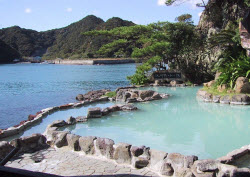Bathe in the Yunishigawa Hot Springs
|
Eight hundred years ago in Japan, weary and defeated Samurai warriors of the Heiki Clan were fleeing from the Seiwa Genji Clan. They had lost the Japan Taira-Minamoto war at the decisive Battle of Dan-no-ura led by Minamoto no Yoshitsune. The exhausted men, now fugitives in their own land, had forfeited everything precious to the Seiwa Genji Clan: their land and their pride. What remaining Heiki Clan refugees were left, to escape capture they sought the safety in the area known as Yunishigawa Onsen, Japan. Here visitors can engage all their senses and experience traces of the ancient Heiki Clan customs that still exist here through the Heiki family descendents that still inhabit this region of Japan.
|
In dire need of, above all things, a warm bath, (Samurai or not, these were Japanese and cleanliness was paramount), the Heiki stumbled upon one of Japan’s great national treasures: the Yunishigawa Onsen – or hot spring in Yunishigawa. Warm, bubbling, frothy masses of pristine water; imbued with the best of nature’s healing minerals and salts – no wonder the clan decided to set up their new village in the area. To this day, strolling among the traditional thatched-roof dwellings in the village, wandering the grounds of Yudonosan Shrine and Takushido Temple, visitors can experience what life must have been like for the ancient warriors and their families.
Yunishigawa may be among the most popular and mystic of Japanese hot springs, but it is by no means the only one. Being highly volcanically active, 'O-yu': literally meaning 'hot water', tends to pounce out of every Japanese regional underground pore – bringing with them the cute little resort towns and spa facilities that become an inevitable part of this type of phenomenon.
Today, the baths come in a variety of sizes and shapes. Moreover, each one has its own unique blend of minerals and acids – supposedly containing healing properties for different but specific ailments.
Visitors can either choose to take a dip in a public and relatively cheap day bath, run by the municipality, or stay at a luxurious ryokan, or traditional Japanese inn – a highly pampering but expensive option. Some ryokan however do allow visitors to have a soak even if not staying there – which is a cheaper way to enjoy the experience – albeit briefly.
For newbies, two brilliant books on Japanese hot springs are 'A Guide to Japanese Hot Springs' and 'Japans Hidden Hot Springs'- both well worth seeking on your travels through the land.
Being an immaculately well-mannered nation, it hardly comes as a surprise that bathing at an onsen has its own, unwritten but very prevalent, etiquette manual. (This despite the fact that the ‘naked companionship in onsen’ experience is something many Japanese seek to actually help shed social constrictions.)
Here are a few points worth noting before diving in:
- First, please do not dive in. Not only is this exceedingly bad mannered from a Japanese perspective; you’re likely to crack your skull as the waters are shallow.
- Bathers are required to wash themselves thoroughly at the showers or taps provided before entering the onsen.
- Do not use soap in the onsen; again, this can be done at the showers provided.
- Carry a small ‘modesty towel’ to delicately cover privates upon entering. Once safely underwater, this towel may be used to scrub your body, or wrung out and placed upon the head. The latter strange rite, it is rumoured by local experts, prevents fainting in the bath.
A little practice will allow the debuting bather to grasp these comforts thoroughly. In the meantime, should you commit a faux pas, just down it with some sake!

|
